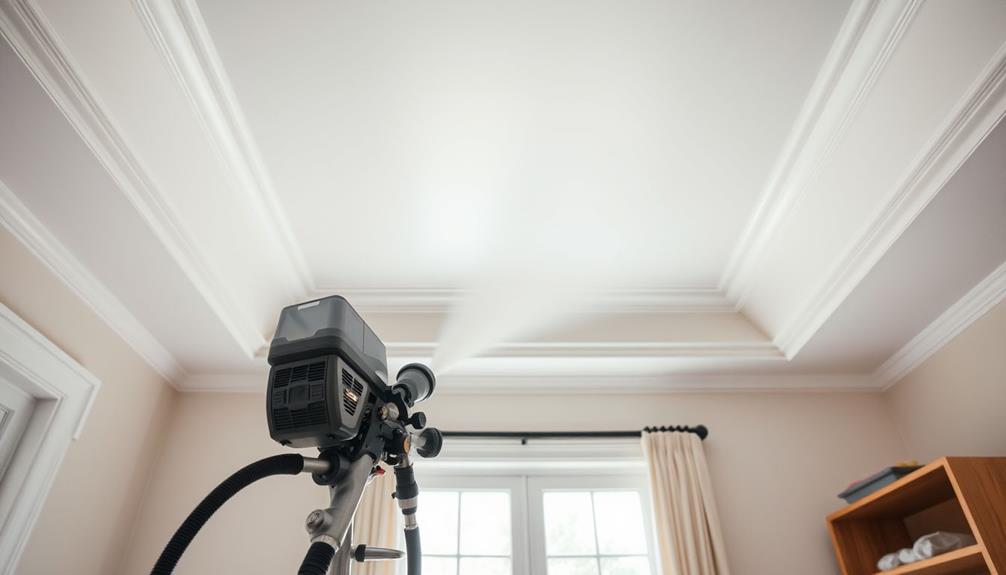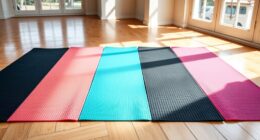Understanding airless spray patterns and fan width control helps you achieve a smooth, professional finish by ensuring even coverage. You form patterns by adjusting the nozzle, pressure, and fan width, which directly impacts how paint disperses on surfaces. Different patterns suit specific tasks, from detailed work to large-area coverage. Fine-tuning fan width improves consistency and minimizes waste. Keep exploring to learn techniques that perfect your spray application and enhance your results.
Key Takeaways
- Proper nozzle alignment and fan control adjust spray pattern width for even coverage and reduced waste.
- Different spray patterns (narrow, wide, horizontal, vertical) suit specific project needs for efficiency and quality.
- Adjusting fan width helps achieve uniform coverage, minimizes overspray, and enhances finish quality.
- Regular inspection and maintenance of spray tips ensure consistent pattern shape and prevent irregularities.
- Environmental factors, paint viscosity, and equipment settings influence spray pattern quality and require careful troubleshooting.
How Airless Spray Patterns Are Formed
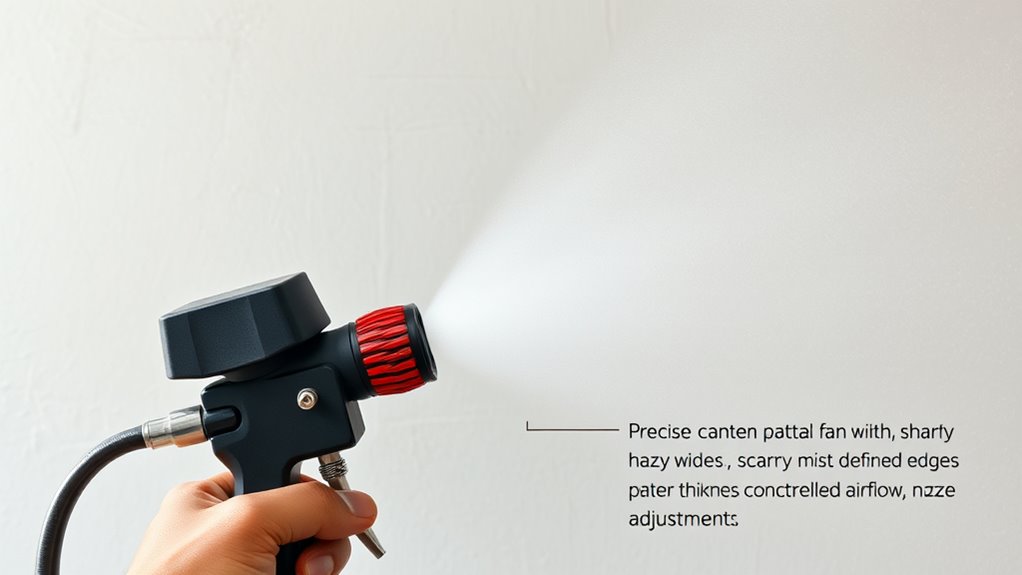
Airless spray patterns are created by the high-pressure fluid exiting the spray tip, which atomizes the paint into tiny droplets. To achieve a consistent spray pattern, you need proper nozzle alignment, ensuring the nozzle is correctly positioned relative to your target surface. When the nozzle is aligned correctly, the spray pattern becomes symmetrical, providing an even coating. If the nozzle is misaligned, the pattern may become uneven or distorted, leading to uneven coverage and wasted paint. Maintaining proper spray pattern symmetry involves checking that the nozzle is centered and parallel to the surface. Regularly inspecting and adjusting your nozzle alignment helps produce a uniform, controlled spray pattern, making your painting job more efficient and professional-looking. Additionally, understanding spray pattern formation can help you troubleshoot issues and improve your overall technique.
Different Types of Spray Patterns and Their Uses
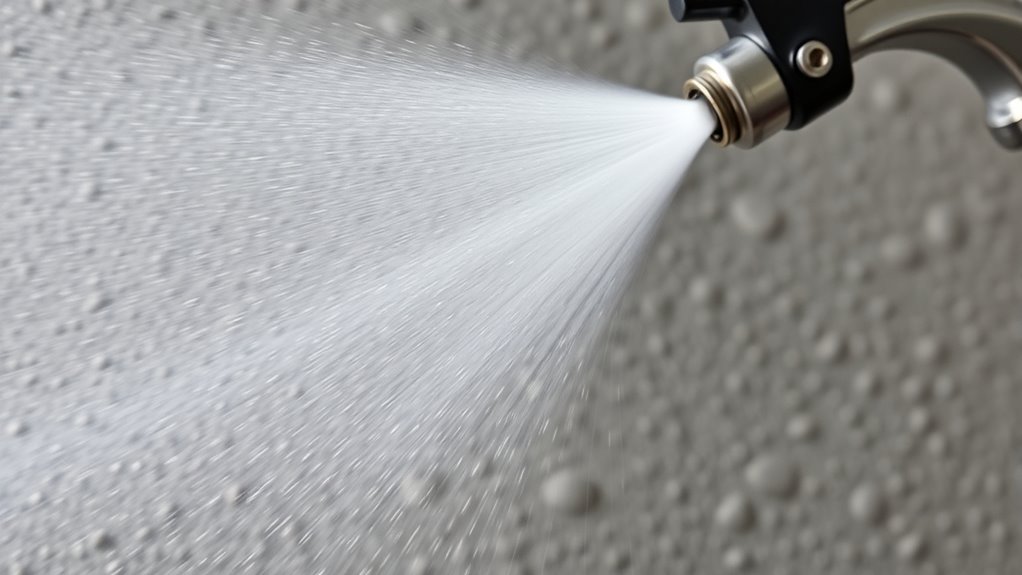
Different spray patterns serve specific purposes depending on the project requirements. For detailed tasks like paint mixing or color matching, a narrow, focused spray pattern provides precision, ensuring accurate application without overspray. Wide spray patterns cover large areas quickly, ideal for priming or base coats. Horizontal patterns help achieve uniform coverage on flat surfaces, while vertical patterns suit textured or uneven surfaces. Knowing these patterns helps you select the right one for your project, enhancing efficiency and quality. Remember, different spray patterns influence the look and finish of your work, making understanding their uses essential. Whether you’re fine-tuning color matching or applying a smooth finish, matching the spray pattern to your task results in professional-quality outcomes.
The Role of Fan Width in Achieving Even Coverage

Adjusting the fan width helps you achieve more uniform coverage, preventing overspray or missed spots. When you widen the fan, it influences the overall finish quality by spreading paint more evenly. Finding the right fan width ensures your application looks smooth and professional. Additionally, understanding the exfoliating properties of glycolic acid can enhance your approach to achieving an even, radiant finish.
Adjusting for Uniformity
Achieving even coverage with an airless spray depends largely on controlling the fan width. Proper adjustment guarantees consistent paint flow, maintains paint consistency, and accounts for environmental conditions that may affect spray patterns. When you fine-tune the fan width, you minimize overspray and optimize coverage. Consider these factors to improve uniformity:
- Adjust fan width based on surface shape and size
- Monitor environmental conditions like humidity and temperature
- Maintain steady pressure to prevent paint inconsistencies
- Regularly inspect and calibrate spray equipment for precision
- Color accuracy plays a role in ensuring the final finish looks uniform and true to the intended shade.
Impact on Finish Quality
Proper fan width settings directly influence the quality of your paint finish. When you adjust the fan width correctly, you guarantee even coverage, which helps with color matching and achieving a consistent look. A fan that’s too wide may cause overspray, leading to uneven coats and potential color mismatches. Conversely, a narrow fan can result in missed spots and uneven textures. Proper control minimizes overspray, reducing environmental impact by limiting paint waste and VOC emissions. Consistent fan width helps you maintain the desired finish quality, whether you’re working on small touch-ups or large projects. Ultimately, paying attention to fan width enhances the overall appearance of your work while also supporting environmentally responsible practices. Additionally, understanding spray pattern techniques can further improve your spraying efficiency and finish quality.
Techniques for Adjusting Fan Width on Airless Sprayers

To adjust the fan width on your airless sprayer, start by selecting the appropriate spray tip size for your project. Use the fan control knob to fine-tune the spray pattern and maintain consistent coverage. Applying these techniques guarantees a smooth, even finish every time you spray. For optimal results, consider the effectiveness of spray patterns and ensure proper technique to achieve a professional look.
Adjusting Spray Tip Size
Adjusting the spray tip size is essential for controlling the fan width and achieving the desired coverage. Proper spray tip selection influences the spray pattern, ensuring even application and minimizing overspray. To optimize results, consider the following:
- Choose a tip size compatible with your project’s coverage needs
- Adjust fluid flow to match the spray tip’s capacity
- Select tips with appropriate orifice sizes for precise fan width control
- Match spray tip type to your material viscosity and surface texture
Using Fan Control Knob
Have you ever wondered how to fine-tune the spray pattern on your airless sprayer? The fan control knob allows you to easily adjust the pattern width for better coverage. Turning the knob changes the fan width, giving you precise pattern adjustment to suit your project. Typically, turning clockwise narrows the spray, ideal for detailed work, while turning counterclockwise widens it for broader coverage. Use the following table to understand common settings:
| Fan Control Setting | Pattern Width |
|---|---|
| Fully clockwise | Narrow (detail work) |
| Slightly clockwise | Medium width |
| Center | Standard pattern |
| Slightly counterclockwise | Wider coverage |
| Fully counterclockwise | Wide fan (large areas) |
Adjust the fan control to optimize your spray pattern for better results. Additionally, understanding the fan width control helps you achieve more efficient coverage and reduces overspray.
Techniques for Consistent Coverage
Maintaining consistent coverage with your airless sprayer hinges on effectively adjusting the fan width throughout your project. To achieve uniform color matching and avoid uneven patches, you need to regularly fine-tune the spray pattern. Start by testing on scrap material, then adjust the fan control knob incrementally. Keep safety precautions in mind—wear protective gear and ensure proper ventilation to prevent overspray. For precise control, consider these techniques:
- Regularly inspect spray pattern during application
- Use a consistent distance from the surface
- Adjust fan width based on surface texture and shape
- Maintain steady hand movements for uniform coverage
Factors That Influence Spray Pattern Quality

Several factors directly influence the quality of an airless spray pattern, and understanding them can help you achieve more consistent and even results. First, paint consistency is vital; if your paint is too thick or too thin, it can cause uneven spray or clogging. Always mix your paint thoroughly and adjust the viscosity as recommended. Environmental factors also play a role; temperature, humidity, and wind can impact how the paint atomizes and deposits. High humidity or wind can cause overspray or uneven coverage, while extreme temperatures may affect drying times and spray consistency. Additionally, the pressure setting and nozzle choice directly affect the spray pattern’s shape and width. By controlling these factors, you’ll improve pattern quality and guarantee a smooth, professional finish.
Tips for Troubleshooting Spray Pattern Issues
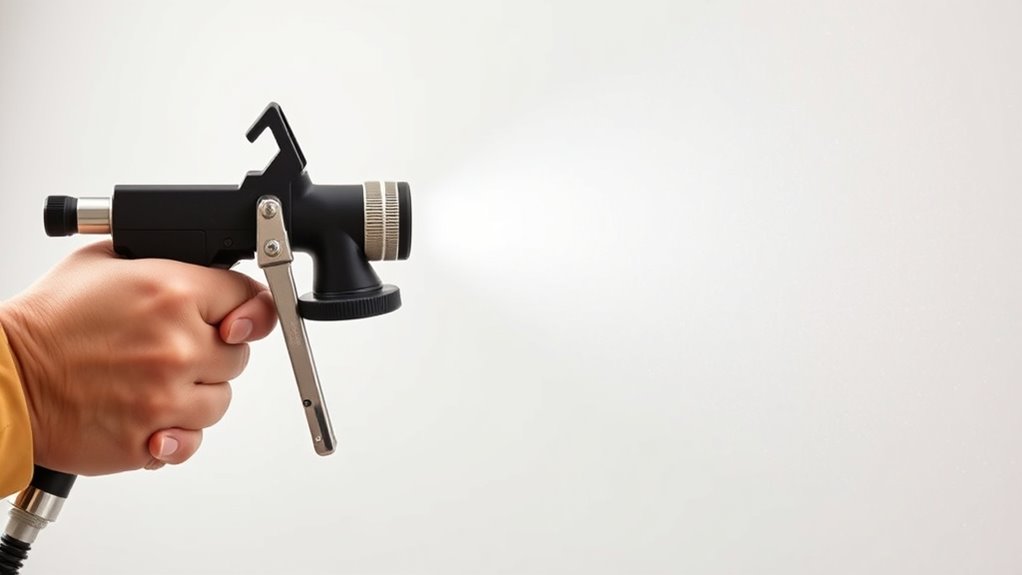
When you notice uneven spray patterns, it’s often a sign that something’s off with your setup or technique. First, check your paint mixing to ensure the paint is properly thinned and free of clumps. Next, inspect your spray tip for clogs or wear, as this can distort the pattern. Confirm that your pressure settings are appropriate for the job. Additionally, always follow safety precautions, including wearing protective gear and working in a well-ventilated area. Here are some troubleshooting tips:
- Clean or replace clogged spray tips
- Adjust pressure and fan width settings
- Ensure consistent paint mixing
- Review safety measures before adjustments
- Regular maintenance of equipment helps prevent issues and maintains optimal spray patterns
Addressing these issues improves spray quality and maintains safety during your project.
Practical Applications of Customized Spray Patterns
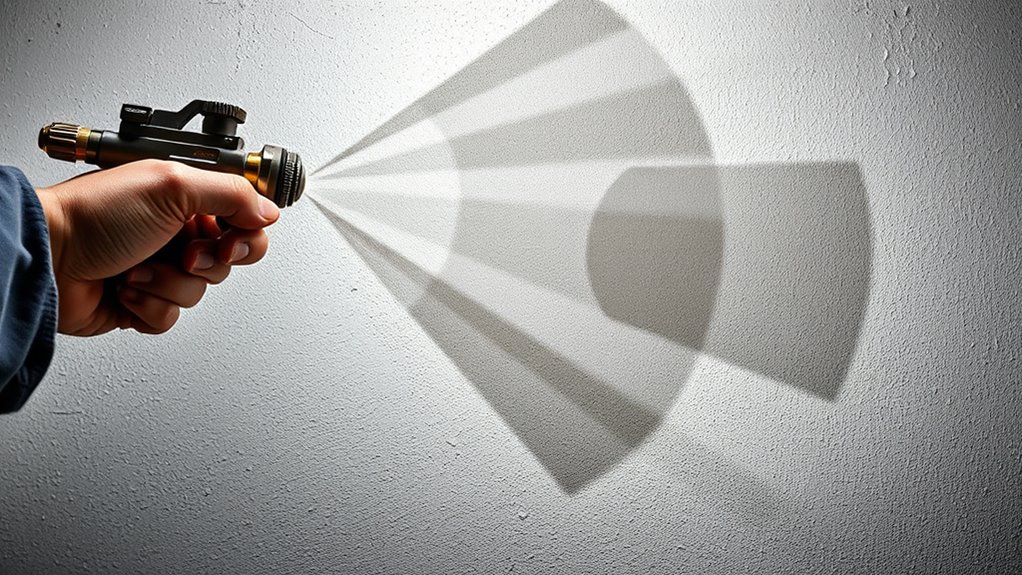
Customized spray patterns allow you to adapt your spray equipment to specific project requirements, resulting in more efficient and precise application. By tailoring the spray fan width and pattern shape, you can achieve better color mixing and reduce overspray, which minimizes environmental impact. For example, a narrower pattern suits detailed work, while a wider pattern covers large surfaces faster. Using the right pattern helps control paint flow and reduces waste. Consider this table for practical application:
| Application Type | Recommended Pattern |
|---|---|
| Fine detail work | Narrow, focused spray pattern |
| Large surface areas | Wide, fan-shaped spray pattern |
| Eco-friendly projects | Minimize overspray to lessen environmental impact |
Adjusting your spray pattern ensures ideal results and supports sustainable practices, emphasizing the importance of mindful decluttering in maintaining organized and environmentally conscious workspaces.
Frequently Asked Questions
How Does Spray Pattern Affect Paint Coverage Efficiency?
You’ll find that spray pattern directly impacts your paint coverage efficiency. A consistent spray pattern ensures even coverage, reducing over-application and waste. When the pattern is well-controlled, you get better spray consistency, which promotes ideal paint adhesion on surfaces. This means fewer coats are needed, saving you time and material. Properly adjusting your spray pattern helps you achieve a uniform finish, making your painting project more efficient and professional-looking.
Can Adjusting Fan Width Impact Paint Overspray?
You might notice that adjusting fan width directly impacts paint overspray. When you widen the fan, it covers more surface area but can lead to increased overspray, wasting paint and creating a mess. Narrowing the fan improves overspray control, giving you precise coverage. So, if you want cleaner results and less waste, tweak your fan width accordingly—smaller for detail work, wider for broader surfaces.
What Safety Precautions Are Necessary When Modifying Spray Patterns?
When modifying spray patterns, you should always prioritize safety. Wear protective gear like masks, goggles, and gloves to prevent paint inhalation and skin contact. Guarantee proper ventilation requirements are met to avoid inhaling fumes and overspray buildup. Keep a safe distance from the spray area, and follow manufacturer instructions. Taking these precautions minimizes health risks and ensures safe, effective adjustments to your spray pattern.
Are Certain Spray Patterns Better for Specific Surfaces?
When choosing spray patterns, you’ll find some work better depending on the surface texture and paint adhesion needs. For rough or textured surfaces, a wider fan pattern helps cover more area evenly, ensuring good paint adhesion. On smooth surfaces, a narrower pattern provides more control and detail. Always match your spray pattern to the surface’s characteristics to achieve a professional finish and ideal paint adhesion.
How Does Environmental Humidity Influence Spray Pattern Quality?
Oh, the irony isn’t lost—humidity effects can sabotage your perfect spray pattern quality just when you think you’re all set. High humidity causes the paint to dry slower, leading to uneven coverage and drips. Low humidity can make the paint dry too fast, causing inconsistent fan width and pattern disruptions. So, keep an eye on the weather; humidity plays a sneaky role in your spray’s success or failure.
Conclusion
Mastering airless spray patterns and fan width control lets you achieve flawless finishes every time. Did you know that adjusting fan width can save you up to 30% in material and time? By understanding how to customize your spray pattern, you’ll guarantee even coverage and professional results on any project. Keep experimenting with settings, troubleshoot issues promptly, and enjoy the efficiency of perfectly tailored spray patterns—your painting projects will never be the same.




